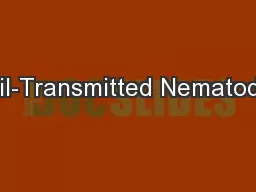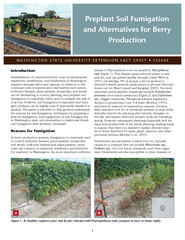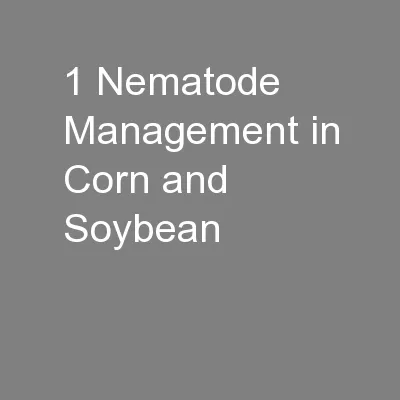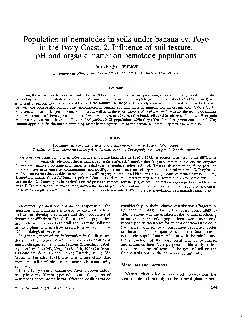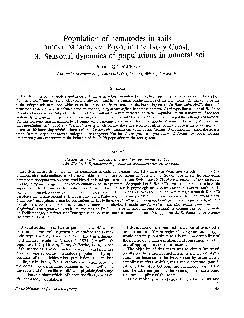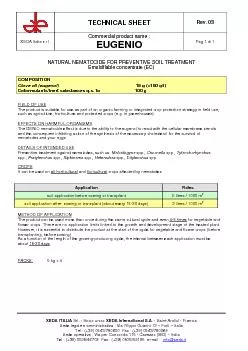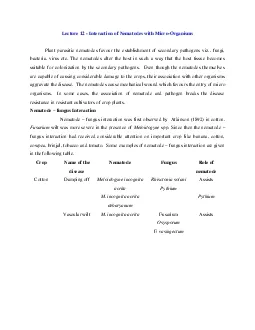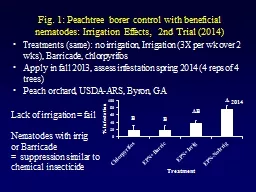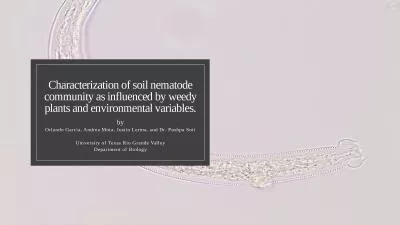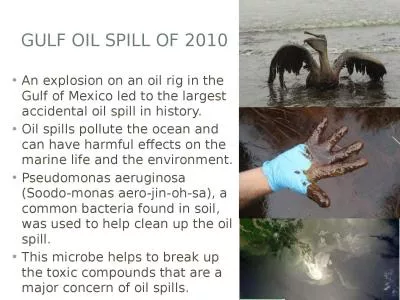PPT-Soil-Transmitted Nematodes
Author : sherrill-nordquist | Published Date : 2019-06-21
And pinworms later on Hookworms Ascaris Whipworm Nematodes The most common macroparasite and can infect humans along with other organisms mammals to plants Impermeable
Presentation Embed Code
Download Presentation
Download Presentation The PPT/PDF document "Soil-Transmitted Nematodes" is the property of its rightful owner. Permission is granted to download and print the materials on this website for personal, non-commercial use only, and to display it on your personal computer provided you do not modify the materials and that you retain all copyright notices contained in the materials. By downloading content from our website, you accept the terms of this agreement.
Soil-Transmitted Nematodes: Transcript
And pinworms later on Hookworms Ascaris Whipworm Nematodes The most common macroparasite and can infect humans along with other organisms mammals to plants Impermeable cuticle and have a complete digestive system with a mouth and anus. The soil should be neutral or slightly acidic with pH 65 to 70 having high organic content Very light sandy soils are not recommended owing to their poor moisture holding properties Climate Light Light is one of the most important climatic factors i 1 and Alternatives for Berry Production WASHINGTON STATE UNIVERSITY EXTENSION FACT SHEET • FS064E Introduction raspberries, strawberries, and blueberries) in Washington requires extensive lab Jason Bond, Plant Pathologist. Southern Illinois University. jbond@siu.edu. 618-453-4309. Nematodes as Pathogens. Nematodes in corn production. Why the interest now?. Potential impact of nematodes. Management options. Matthew 13:1-23. Soil that Hears; Soil that Listens. 1. The Parable Presented. Soil that Hears; Soil that Listens. Matthew 13:1-9. That same day Jesus went out of the house and sat beside the sea. And great crowds gathered about him, so that he got into a boat and sat down. And the whole crowd stood on the beach. . By the end of this section you will be able..... To name and explain the causes of soil erosion.. Describe in detail how human activities can cause soil erosion.. Name and explain the primary methods of soil conservation.. Bacteria (10,000,000,000,000). Protozoa (10,000,000,000). Fungi (100,000,000,000). Nematodes (5,000,000). Mites (100,000). Springtails (50,000). Rotifers (10,000). Insects and Spiders (5,000). Potworms. Patrick QUÉNÉHERVÉ Laboratoire de Nématologie, Centre ORSTOM, B.P. V 51, Abidjan, Côte d%oire. During the nematicide tests carried out between 1980 and 1985 mmpaed in relation to some soil var P. Quéne3erué given below wet season FLUCTUATION OF shows clearly rainy season, each successive only species ~ ~~~ showed several major infestation by 82) which rainfall periods. several major clos XEDA Italia s.r.l. XEDA ITALIA Srl. - Socio unico EVENTIVE SOIL TREATMENT COMPOSITION 18 g (=180 g/l) Coformulants/inert substances q.s. to 100 g FIELD OF USE The product is suita Lecture 12 --OrganismsPlant parasitic nematodes favour the establishment of secondary pathogens viz fungi bacteria virus etc The nematodes alter the host in such a way that the host tissue becomes sui Effects, 2nd . Trial (2014). Treatments (same): . n. o irrigation, Irrigation (3X per . wk. over 2 . wks. ), Barricade, chlorpyrifos. Apply in fall 2013, assess infestation spring 2014 (4 reps of 4 trees). by. Orlando Garcia, Andrea Mota, Justin Lerma, and Dr. Pushpa Soti. University of Texas Rio Grande Valley. Department of Biology. Soil nematode community. What are nematodes?. •Microscopic roundworm . Oil spills pollute the ocean and can have harmful effects on the marine life and the environment.. Pseudomonas . aeruginosa. (. Soodo. -monas aero-. jin. -oh-. sa. ), a common bacteria found in soil, was used to help clean up the oil spill.. Figure 3-24. Fig. 3-24a, p. 69. Mosaic of closely packed pebbles, boulders. Weak humus-mineral mixture. Dry, brown to reddish-brown with variable accumulations of clay, calcium and carbonate, and soluble salts.
Download Document
Here is the link to download the presentation.
"Soil-Transmitted Nematodes"The content belongs to its owner. You may download and print it for personal use, without modification, and keep all copyright notices. By downloading, you agree to these terms.
Related Documents

